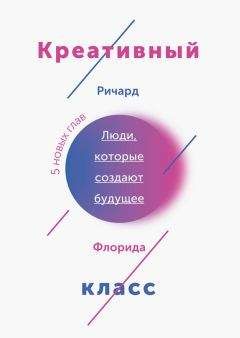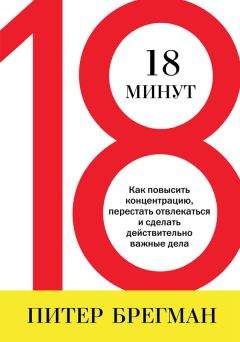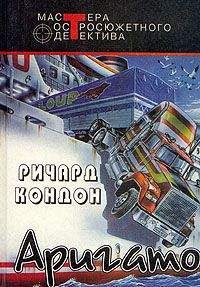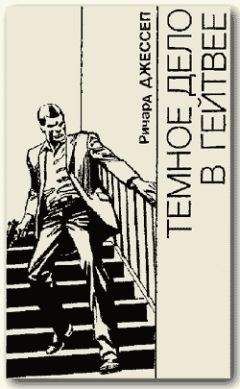Ричард convertfileonline.com - _2016_02_09_21_40_03_404

Скачивание начинается... Если скачивание не началось автоматически, пожалуйста нажмите на эту ссылку.
Жалоба
Напишите нам, и мы в срочном порядке примем меры.
Описание книги "_2016_02_09_21_40_03_404"
Описание и краткое содержание "_2016_02_09_21_40_03_404" читать бесплатно онлайн.
Индекс креативности — сводный индекс, рассчитываемый на основании этих трех показателей.
Примечания
Предисловие
[1] См. http://blog.linkedin.com/2011/12/13/buzzwords-redux/.
[2] Erick Schonfeld, “The Rise of the ‘Creative’ Class,” TechCrunch, December 14, 2011; в сети доступно здесь: http://techcrunch.com/2011/12/14/creative-class/.
[3] Joseph Stiglitz, “The Book of Jobs,” Vanity Fair, January 2012.
[4] См. Kenneth Rogoff and Carmen Reinhart, This Time Is Different: Eight Centuries of Financial Folly. Princeton: Princeton University Press, 2009); см. также мою книгу: The Great Reset: How New Ways of Living and Working Drive Post-Crash Prosperity. New York: Harper, 2010 (издана на русском языке: Флорида Р. Большая перезагрузка: как кризис изменит наш образ жизни и рынок труда. М. : Классика-XXI, 2012).
[5] См., например: Ronald Ingelhart, “Post-Materialism in an Environment of Insecurity,” American Political Science Review 75 (4) (December 1981): 880–900.
[6] Andrew Whitehead, “Eric Hobsbawm on 2011,” BBC World Service News, December 22, 2011. Режим доступа: www.bbc.co.uk/news/magazine-16217726.
Глава 1
[1] Более тщательное эмпирическое сравнение технологий в начале ХХ столетия и в наше время можно найти в работе: RobertGordon, “Does the New Economy Measure Up to the Great Inventions of the Past?” Working Paper No. 7833, National Bureau of Economic Research, Cambridge, MA, August 2000 (издана на русском языке: Гордон Р. Достигла ли новая экономика уровня великих изобретений прошлого?). Ответ Роберта Гордона — категорическое «нет». Подавляющее большинство технических изобретений, которые включены в список величайших инженерных достижений ХХ столетия, составленный Национальной технической академией, были сделаны до 1950 года. Только два из первых десяти изобретений были сделаны после Второй мировой войны (полупроводниковая электроника — номер пять, а также компьютеры — номер восемь), тогда как интернет занял 13-е место в 2000 году.
[2] К числу самых популярных работ по этой теме относятся следующие книги: SinclairLewis, Main Street. New York: Harcourt, Brace, 1920; Babbitt. New York: Harcourt, Brace and World, 1922 (издана на русском языке: Льюис С. Главная улица. Бэббит. М.: Художественная литература. 1989); William H. Whyte Jr., The Organization Man. New York: Simon and Schuster, 1956; David Riesman, The Lonely Crowd: A Study of the Changing American Character. New Haven: Yale University Press, 1950; C. Wright Mills, White Collar: The American Middle Classes New York: Oxford University Press, 1951; John Kenneth Galbraith, The New Industrial State. New York: Houghton-Mifflin, 1967 (издана на русском языке: Гэлбрейт Дж. Новое индустриальное общество. М.: Эксмо, 2008). См. также: Anthony Sampson, Company Man: The Rise and Fall of Corporate Life. New York: Times Books, 1995.
[3] Dean Keith Simonton, “Creativity: Cognitive, Developmental, Personal, and Social Aspects,” American Psychologist 55 (2000): 151–158; “Big-C Creativity in the Big City,” in David Emanuel Andersson, Åke Emanuel Andersson, and Charlotta Mellander, eds. Handbook of Creative Cities. Cheltenham, UK: Edward Elgar, 2011, pp. 72–84.
[4] Существует много публикаций на эту тема, и самая заметная из них: Daniel Pink, Free Agent Nation: How America’s New Independent Workers Are Transforming the Way We Live. New York: Warner Books, 2001 (издана на русском языке: Пинк Д. Нация свободных агентов. М. : Секрет фирмы, 2005).
[5] По этой теме также есть много публикаций, самая последняя из которых: Kevin Kelly, New Rules for the New Economy: Ten Radical Strategies for a Connected World. New York: Viking, 1998.
[6] Карли Фиорина выступила с докладом на ежегодной конференции Национальной ассоциации губернаторов в Вашингтоне зимой 2000 года, где и произнесла эти слова.
[7] Классические высказывания об этом можно найти в работах Карла Маркса «Капитал» и «Манифест Коммунистической партии», а также во многих других его работах.
[8] Daniel Bell, The Coming of Post-Industrial Society. New York: Basic Books, 1973 (издана на русском языке: Белл Д. Грядущее постиндустриальное общество. Опыт социального прогнозирования. М. : Асаdemia, 2004).
Глава 2
[1] См.: Paul Romer, “Economic Growth,” in The Fortune Encyclopedia of Economics, David R. Henderson, ed. New York: Time Warner Books, 1993, p. 9; “Ideas and Things,” Economist, September 11, 1993, p. 33; “Beyond the Knowledge Worker,” Worldlink (January-February 1995); доступно также на его сайте. Классическая работа по этой теме: Romer, “Endogenous Technical Change,” Journal of Political Economy 98 (5) (1990): 71–102.
[2] Joseph Schumpeter, Capitalism, Socialism and Democracy. New York: Harper and Row, first edition 1942, second [revised] edition 1947, third and final author’s revision 1950; quotes are from Harper Torchbooks edition of the latter, 1975, pp. 132–134 (издана на русском языке: Шумпетер Й. Капитализм, социализм и демократия. М. : Экономика, 1995).
[3] Из личного интервью автора, лето 2000 года.
[4] См., например: Arthur Koestler, The Act of Creation. London: Hutchinson, 1964; Margaret Boden, The Creative Mind: Myths and Mechanisms. New York: Basic Books, 1990; Robert J. Sternberg, ed., Handbook of Creativity New York: Cambridge University Press, 1999; Dean Keith Simonton, Origins of Genius: Darwinian Perspectives on Creativity. New York: Oxford University Press, 1999; Carl R. Rogers, “Toward a Theory of Creativity,” chap. 19 in his On Becoming a Person: A Therapist’s View of Psychotherapy. Boston: Houghton Mifflin, 1961; Douglas Hofstader, Godel, Escher, Bach: An Eternal Golden Braid. New York: Basic Books, 1979 (издана на русском языке: Хофштадтер Д. Гедель, Эшер, Бах. Эта бесконечная гирлянда. Самара : Бахрах-М, 2001); Silvano Arieti, Creativity: The Magic Synthesis. New York: Basic Books, 1976.
[5] См.: Antonio Preti and Paolo Miotto, “The Contribution of Psychiatry to the Study of Creativity: Implications for AI Research,” at http://cogprints.org/2026/, p. 2. См. также: F. Barron and D. M. Harrington, “Creativity, Intelligence and Personality,” Annual Review of Psychology 32 (1981): 439—476; D. W. McKinnon, “The Nature and Nurture of Creative Talent,” American Psychologist 17 (1962): 484–494; M. Dellas and E. L. Gaier, “Identification of Creativity in Individuals,” Psychological Bulletin 73 (1970): 55–73.
[6] См.: Boden, The Creative Mind; Arieti, Creativity: The Magic Synthesis; S. A. Mednick, “The Associative Basis of the Creative Process,” Psychological Review 69 (1968): 220–232.
[7] Boden, The Creative Mind, p. 255. См. также: Thomas Kuhn, The Structure of Scientific Revolutions. Chicago: University of Chicago Press, 1962.
[8] Joel Mokyr, The Lever of Riches: Technological Creativity and Economic Progress. New York: Oxford University Press, 1990. Впервые Шумпетер упомянул об этом различии в своей статье: “The Creative Response in Economic History,” Journal of Economic History 7(1947): 149–159.
[9] Boden, The Creative Mind, p. 245.
[10] Boden, The Creative Mind, с. 255–256.
[11] Simonton, Origins of Genius.
[12] Цит. по: Boden, The Creative Mind, p. 254.
[13] Boden, The Creative Mind, pp. 254–255.
[14] Wesley Cohen and Daniel Levinthal, “Fortune Favors the Prepared Firm,” Management Science (February 1994): 227–251.
[15] Anthony Storr, Churchill’s Black Dog, Kafka’s Mice and Other Phenomena of the Human Mind. New York: Grove Press, 1988, p. 103.
[16] Teresa M. Amabile, Creativity in Context. Boulder: Westview Press, 1996, p. 15. Впервые опубликована под названием Social Psychology of Creativity,1983.
[17] Цит. по: Thomas P. Hughes, American Genesis: A Century of Invention and Technological Enthusiasm. New York: Viking, 1989, p. 29.
[18] Simonton, Origins of Genius, pp. 206–212.
[19] Mokyr, The Lever of Riches, p. 16; об этом предупреждении идет речь здесь: Epilogue, p. 301.
[20] Paul Romer, “Ideas and Things,” Economist, September 11, 1993, online version, p. 2.
[21] Исчерпывающее описание новой теории роста представлено здесь: Joseph Cortwright, “New Growth Theory, Technology and Learning: A Practitioner’s Guide to Theories for the Knowledge Based Economy,” report prepared for the US Economic Development Administration, Washington, DC, 2000.
[22] Lawrence Lessig, The Future of Ideas. New York: Random House, 2001.
[23] Adam Smith, The Wealth of Nations. New York: Bantam, 2003 [first ed., 1776] (издана на русском языке: Смит А. Исследование о природе и причинах богатства народов. М. : Эксмо, 2007).
[24] John Seely Brown and Paul Duguid, The Social Life of Information. Boston: Harvard Business School Press, 2000.
[25] William H. Whyte Jr., The Organization Man. New York: Simon and Schuster, 1956.
[26] Jane Jacobs, The Death and Life of Great American Cities. New York: Random House, 1961 (издана на русском языке: Джекобс Дж. Смерть и жизнь больших американских городов. М. : Новое издательство, 2011).
[27] Интервью, проведенное Джеймсом Канстлером 6 сентября 2000 года в Торонто (Канада) для журнала Metropolis Magazine, March 2001. В интернете доступно на сайте: www.kunstler.com/mags_jacobs1.htm.
[28] Peter Drucker, Post-Capitalist Society. New York: Harper Business, 1993, quote from p. 8; см. также: “Beyond the Information Revolution,” Atlantic Monthly 284 (4) (October 1999): 47–57; “The Next Society,” Economist, November 1, 2001 (Economist Survey), pp. 1–20. Считается, что первым этот термин использовал Фриц Махлуп в книге, опубликованной в 1962 году: Fritz Machlup, The Production and Distribution of Knowledge in the United States. Princeton: Princeton University Press, 1962 (издана на русском языке: Махлуп Ф. Производство и распространение знаний в США. М. : Прогресс, 1966). Об экономике знаний писали и многие другие авторы, в том числе: Ikujiro Nonaka and Hiroetaka Takeuchi, The Knowledge Creating Company: How Japanese Companies Create the Dynamics of Innovation. New York: Oxford University Press, 1995; Alan Burton Jones, Knowledge Capitalism: Business, Work and Learning in the New Economy. Oxford: Oxford University Press, 1999. Стивен Бринт приводит исчерпывающий анализ этой темы в своей статье: Steven Brint, “Professionals and the Knowledge Economy: Rethinking the Theory of the Postindustrial Society,” Current Sociology 49 (1) (July 2001): 101–132.
[29] “The Creative Economy,” Business Week, special double issue: The 21st Century Corporation, Business Week Online, August 28, 2000, pp. 1–5.
[30] John Howkins, The Creative Economy. New York: Allen Lane, Penguin Press, 2001. Имеется также интересный доклад по этой теме, в котором используется термин «креативная экономика»: “The Creative Economy Initiative,” by the New England Council, June 2000. Однако в этом отчете определение креативной экономики ограничено художественной и культурной областями.
[31] Другие авторы тоже писали об экономике интеллектуального капитала; см., например: Thomas A. Stewart, Intellectual Capital: The New Wealth of Organizations. New York: Doubleday/Currency, 1997; Leif Edvinsson and Michael S. Malone, Intellectual Capital: Realizing Your Company’s True Value by Knowing Its Hidden Brainpower. New York: Harper-Collins, 1997.
Подписывайтесь на наши страницы в социальных сетях.
Будьте в курсе последних книжных новинок, комментируйте, обсуждайте. Мы ждём Вас!
Похожие книги на "_2016_02_09_21_40_03_404"
Книги похожие на "_2016_02_09_21_40_03_404" читать онлайн или скачать бесплатно полные версии.
Мы рекомендуем Вам зарегистрироваться либо войти на сайт под своим именем.
Отзывы о "Ричард convertfileonline.com - _2016_02_09_21_40_03_404"
Отзывы читателей о книге "_2016_02_09_21_40_03_404", комментарии и мнения людей о произведении.













